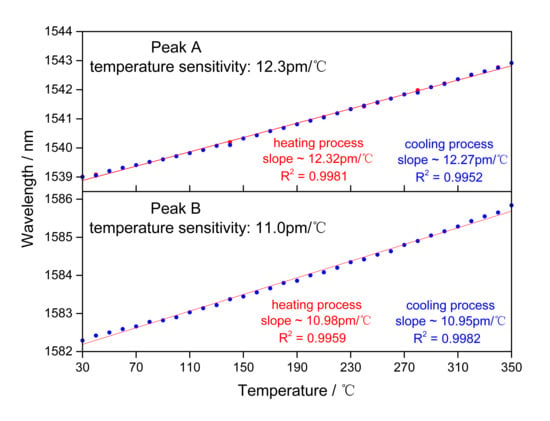A Temperature Fiber Sensor Based on Tapered Fiber Bragg Grating Fabricated by Femtosecond Laser
Abstract
1. Introduction
2. Sensor Structure and Principle
3. Device Fabrication
4. Results and Discussion
5. Conclusions
Author Contributions
Funding
Acknowledgments
Conflicts of Interest
References
- Antonio-Lopez, J.E.; Eznaveh, Z.S.; LiKamWa, P.; Schulzgen, A.; Amezcua-Correa, R. Multicore fiber sensor for high-temperature applications up to 1000 °C. Opt. Lett. 2014, 39, 4309–4312. [Google Scholar] [CrossRef] [PubMed]
- di Sante, R. Fibre Optic Sensors for Structural Health Monitoring of Aircraft Composite Structures: Recent Advances and Applications. Sensors 2015, 15, 18666–18713. [Google Scholar] [CrossRef] [PubMed]
- Yan, S.; Xu, F. A review on optical microfibers in fluidic applications. J. Micromech. Microeng. 2017, 27, 093001. [Google Scholar] [CrossRef]
- Arjmand, M.; Saghafifar, H.; Alijanianzadeh, M.; Soltanolkotabi, M. A sensitive tapered-fiber optic biosensor for the label-free detection of organophosphate pesticides. Sens. Actuators B Chem. 2017, 249, 523–532. [Google Scholar] [CrossRef]
- Li, Y.; Liao, C.; Wang, D.N.; Lu, J.; Lu, P. Fiber Bragg Grating for High Temperature Applications. In Proceedings of the 15th OptoElectronics and Communications Conference (OECC2010) Technical Digest Sapporo Convention Center, Sapporo, Japan, 5–9 July 2010. [Google Scholar]
- Jiang, Y.; Liu, C.; Li, D.; Yang, D.; Zhao, J. Simultaneous measurement of temperature and strain using a phase-shifted fiber Bragg grating inscribed by femtosecond laser. Meas. Sci. Technol. 2018, 29, 045101. [Google Scholar] [CrossRef]
- Ding, M.; Yang, B.; Jiang, P.; Liu, X.; Dai, L.; Hu, Y.; Zhang, B. High-sensitivity thermometer based on singlemode-multimode FBG-singlemode fiber. Opt. Laser Technol. 2017, 96, 313–317. [Google Scholar] [CrossRef]
- Zhang, W.; Hao, J.; Lou, X.; Dong, M.; Zhu, L. All-Fiber Dual-Parameter Sensor Based on Cascaded Long Period Fiber Grating Pair Fabricated by Femtosecond Laser and CO2 Laser. Fiber Integr. Opt. 2018, 37, 66–78. [Google Scholar] [CrossRef]
- Xiang, Y.; Luo, Y.; Li, Y.; Li, Y.; Yan, Z.; Liu, D.; Sun, Q. Quasi-Distributed Dual-Parameter Optical Fiber Sensor Based on Cascaded Microfiber Fabry–Perot Interferometers. IEEE Photonics J. 2018, 10, 2400309. [Google Scholar] [CrossRef]
- Zhang, X.; Peng, W.; Shao, L.; Pan, W.; Yan, L. Strain and temperature discrimination by using temperature-independent FPI and FBG. Sens. Actuators A Phys. 2018, 272, 134–138. [Google Scholar] [CrossRef]
- Theodosiou, A.; Hu, X.; Caucheteur, C.; Kalli, K. Bragg Gratings and Fabry-Perot Cavities in Low-Loss Multimode CYTOP Polymer Fiber. IEEE Photonics Technol. Lett. 2018, 30, 857–860. [Google Scholar] [CrossRef]
- Liao, C.R.; Wang, Y.; Wang, D.N.; Yang, M.W. Fiber In-Line Mach–Zehnder Interferometer Embedded in FBG for Simultaneous Refractive Index and Temperature Measurement. IEEE Photonics Technol. 2010, 22, 1686–1688. [Google Scholar] [CrossRef]
- Hu, Y.; Jiang, C.; Zhou, M.; Liu, J. High-sensitivity fiber temperature and refractive index sensing with nonadiabatic fiber taper. J. Opt. Technol. 2018, 85, 233–237. [Google Scholar] [CrossRef]
- Tan, J.; Feng, G.; Zhang, S.; Liang, J.; Li, W.; Luo, Y. Dual spherical single-mode-multimode-single-mode optical fiber temperature sensor based on a Mach—Zehnder interferometer. Laser Phys. 2018, 28, 075102. [Google Scholar] [CrossRef]
- Talataisong, W.; Ismaeel, R.; Brambilla, G. A Review of Microfiber-Based Temperature Sensors. Sensors 2018, 18, 461. [Google Scholar] [CrossRef]
- Hoeffgen, S.K.; Henschel, H.; Kuhnhenn, J.; Weinand, U.; Caucheteur, C.; Grobnic, D.; Mihailov, S.J. Comparison of the Radiation Sensitivity of Fiber Bragg Gratings Made by Four Different Manufacturers. IEEE Trans. Nucl. Sci. 2011, 58, 906–909. [Google Scholar] [CrossRef]
- O’Byrne, R.P.; Sergeyev, S.V.; Flavin, D.A.; Slattery, S.A.; Nikogosyan, D.N.; Jones, J.D.C. Anisotropic Fiber Bragg Gratings Inscribed by High-Intensity Femtosecond-UV Pulses: Manufacturing Technology and Strain Characterization for Sensing Applications. IEEE Sens. J. 2008, 8, 1256–1263. [Google Scholar] [CrossRef]
- Zheng, Z.; Yu, Y.; Zhang, X.; Guo, Q.; Sun, H. Femtosecond Laser Inscribed Small-Period Long-Period Fiber Gratings with Dual-Parameter Sensing. IEEE Sens. J. 2018, 18, 1100–1103. [Google Scholar] [CrossRef]
- Yang, K.; He, J.; Liao, C.; Wang, Y.; Liu, S.; Guo, K.; Zhou, J.; Li, Z.; Tan, Z.; Wang, Y. Femtosecond Laser Inscription of Fiber Bragg Grating in Twin-Core Few-Mode Fiber for Directional Bend Sensing. J. Lightwave Technol. 2017, 35, 4670–4676. [Google Scholar] [CrossRef]
- Marchi, G.; Stephan, V.; Dutz, F.J.; Hopf, B.; Polz, L.; Huber, H.P.; Roths, J. Femtosecond Laser Machined Micro-Structured Fiber Bragg Grating for Simultaneous Temperature and Force Measurements. J. Lightwave Technol. 2016, 34, 4557–4563. [Google Scholar] [CrossRef]
- Jiang, Y.; Liu, C.; Zhang, W.; Mao, D.; Yang, D.; Zhao, J. Multi-Parameter Sensing Using a Fiber Bragg Grating Inscribed in Dual-Mode Fiber. IEEE Photonics Technol. Lett. 2017, 29, 1607–1610. [Google Scholar] [CrossRef]
- Chen, C.; Zhang, X.; Yu, Y.; Wei, W.; Guo, Q.; Qin, L.; Ning, Y.; Wang, L.; Sun, H. Femtosecond Laser-Inscribed High-Order Bragg Gratings in Large-Diameter Sapphire Fibers for High-Temperature and Strain Sensing. J. Lightwave Technol. 2018, 36, 3302–3308. [Google Scholar] [CrossRef]
- Baghdasaryan, T.; Geernaert, T.; Becker, M.; Schuster, K.; Bartelt, H.; Makara, M.; Mergo, P.; Berghmans, F.; Thienpont, H. Influence of Fiber Orientation on Femtosecond Bragg Grating Inscription in Pure Silica Microstructured Optical Fibers. IEEE Photonics Technol. Lett. 2011, 23, 1832–1834. [Google Scholar] [CrossRef]
- Zhou, K.; Dubov, M.; Mou, C.; Zhang, L.; Mezentsev, V.K.; Bennion, I. Line-by-Line Fiber Bragg Grating Made by Femtosecond Laser. IEEE Photonics Technol. Lett. 2010, 22, 1190–1192. [Google Scholar] [CrossRef]
- Liao, C.; Li, Y.; Wang, D.N.; Sun, T.; Grattan, K.T.V. Morphology and Thermal Stability of Fiber Bragg Gratings for Sensor Applications Written in H2-Free and H2-Loaded Fibers by Femtosecond Laser. IEEE Sens. J. 2010, 10, 1675–1681. [Google Scholar] [CrossRef]
- Donko, A.; Beresna, M.; Jung, Y.; Hayes, J.; Richardson, D.J.; Brambilla, G. Point-by-point femtosecond laser micro-processing of independent core-specific fiber Bragg gratings in a multi-core fiber. Opt. Express 2018, 26, 2039–2044. [Google Scholar] [CrossRef] [PubMed]
- Theodosiou, A.; Lacraz, A.; Stassis, A.; Koutsides, C.; Komodromos, M.; Kalli, K. Plane-by-Plane Femtosecond Laser Inscription Method for Single-Peak Bragg Gratings in Multimode CYTOP Polymer Optical Fiber. J. Lightwave Technol. 2017, 35, 5404–5410. [Google Scholar] [CrossRef]
- Grobnic, D.; Mihailov, S.J.; Smelser, C.W. Localized High Birefringence Induced in SMF-28 Fiber by Femtosecond IR Laser Exposure of the Cladding. J. Lightwave Technol. 2007, 25, 1996–2001. [Google Scholar] [CrossRef]
- Lou, J.; Wang, Y.; Tong, L. Microfiber optical sensors: A review. Sensors 2014, 14, 5823–5844. [Google Scholar] [CrossRef]
- Layeghi, A.; Latifi, H. Magnetic field vector sensor by a nonadiabatic tapered Hi-Bi fiber and ferrofluid nanoparticles. Opt. Laser Technol. 2018, 102, 184–190. [Google Scholar] [CrossRef]
- Silva, S.; Coelho, L.; Almeida, J.M.; Frazao, O.; Santos, J.L.; Malcata, F.X.; Becker, M.; Rothhardt, M.; Bartelt, H. H2 Sensing Based on a Pd-Coated Tapered-FBG Fabricated by DUV Femtosecond Laser Technique. IEEE Photonics Technol. Lett. 2013, 25, 401–403. [Google Scholar] [CrossRef]
- Zhu, F.; Zhang, Z.; Liao, C.; Wang, Y.; Xu, L.; He, J.; Wang, C.; Li, Z.; Yang, T.; Wang, Y. Taper Embedded Phase-Shifted Fiber Bragg Grating Fabricated by Femtosecond Laser Line-by-Line Inscription. IEEE Photonics J. 2018, 10, 1–8. [Google Scholar] [CrossRef]
- Ran, Y.; Jin, L.; Sun, L.; Li, J.; Guan, B. Temperature-Compensated Refractive-Index Sensing Using a Single Bragg Grating in an Abrupt Fiber Taper. IEEE Photonics J. 2013, 5, 7100208. [Google Scholar]
- Sun, D.; Ran, Y.; Wang, G. Label-Free Detection of Cancer Biomarkers Using an In-Line Taper Fiber-Optic Interferometer and a Fiber Bragg Grating. Sensors 2017, 17, 2559. [Google Scholar] [CrossRef] [PubMed]
- Gomes, A.D.; Silveira, B.; Warren-Smith, S.C.; Becker, M.; Rothhardt, M.; Frazão, O. Temperature independent refractive index measurement using a fiber Bragg grating on abrupt tapered tip. Opt. Laser Technol. 2018, 101, 227–231. [Google Scholar] [CrossRef]


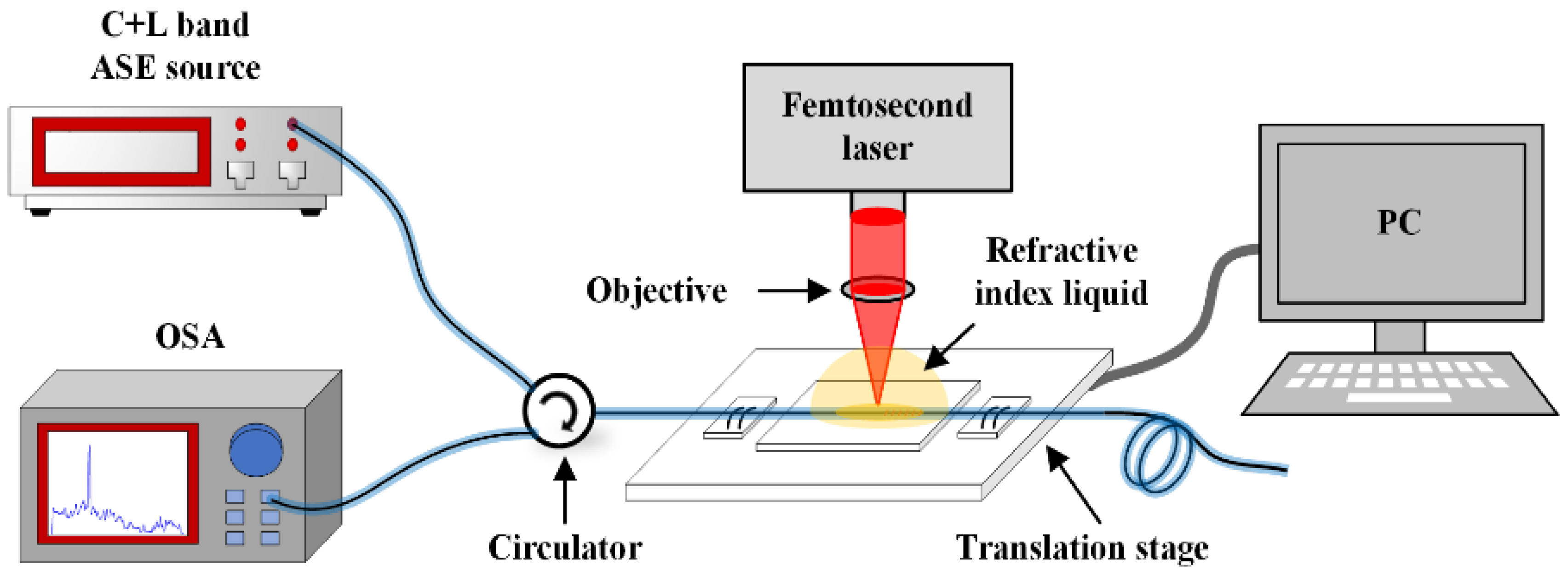
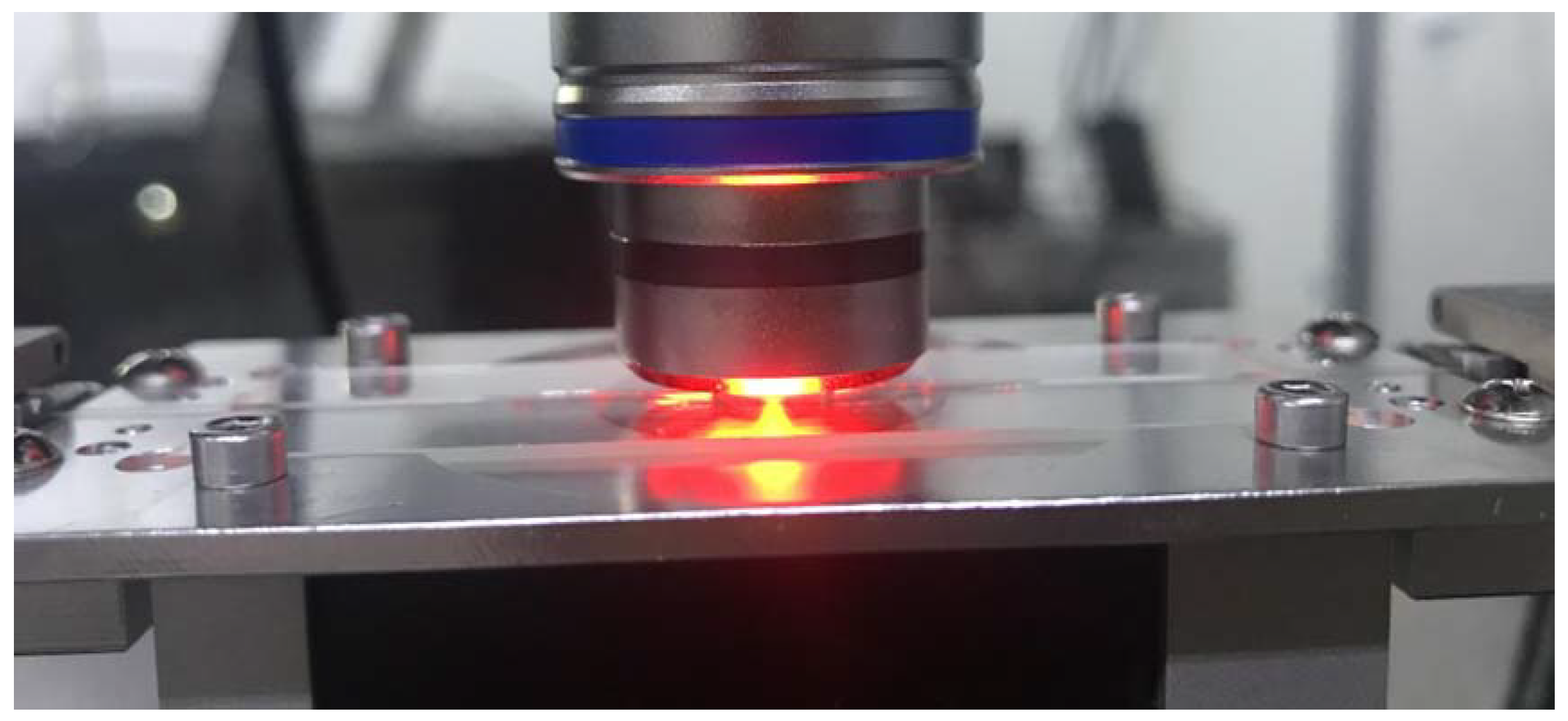
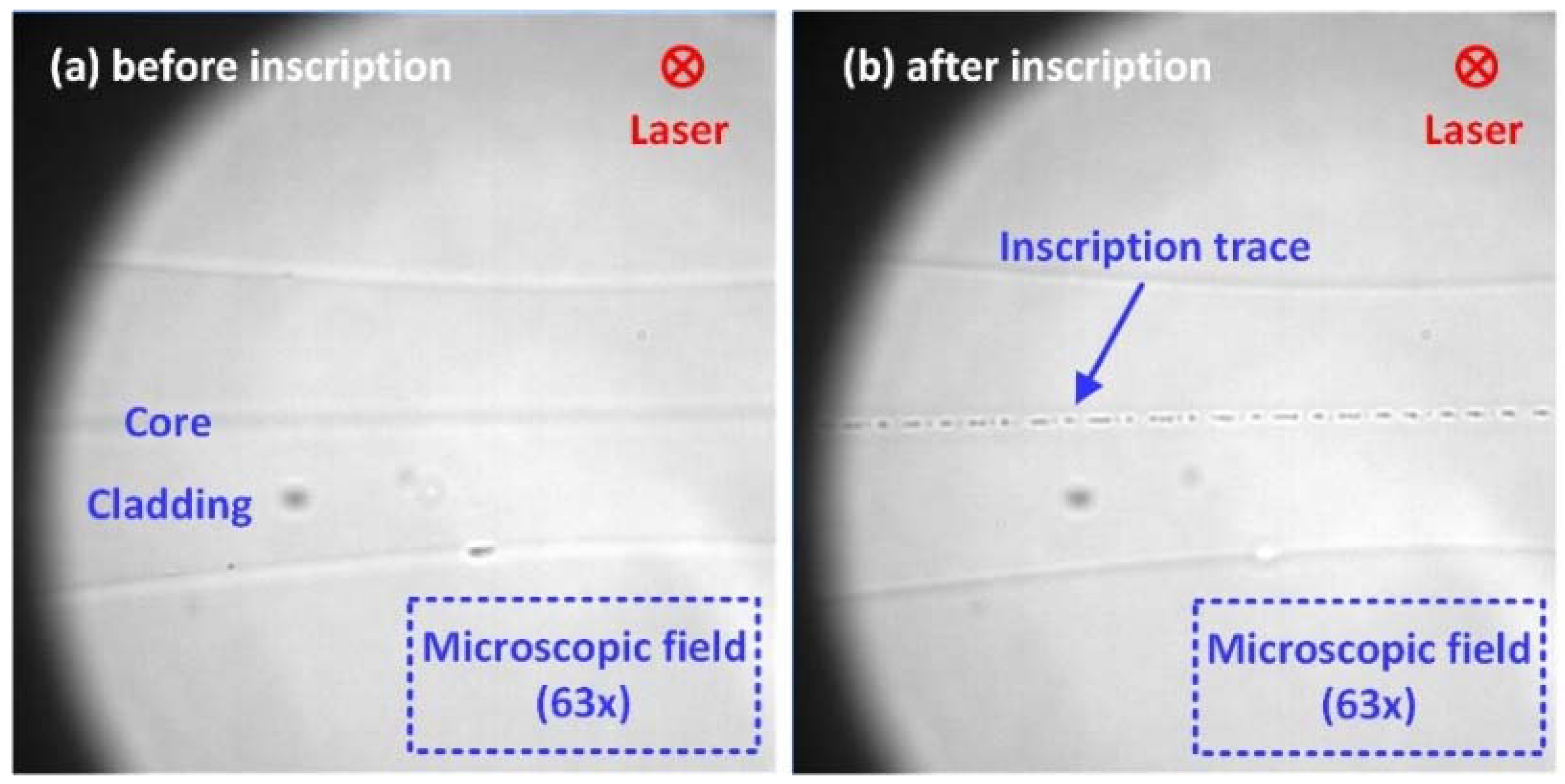


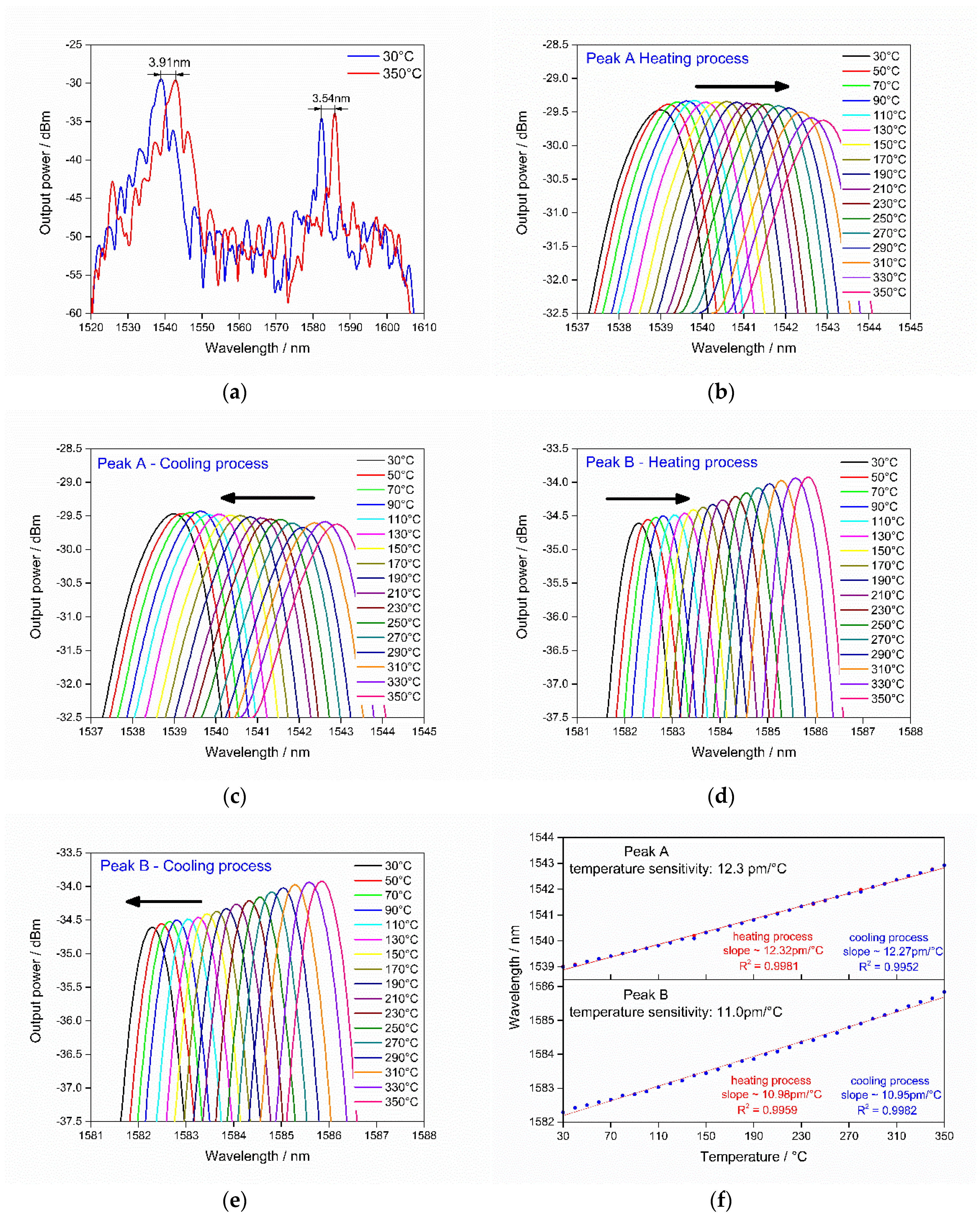
| Peak Index | Grating Pitch (nm) | Grating Length (μm) | Wavelength (nm) | Output Power (dBm) | −3 dB Fractional Bandwidth (nm) |
|---|---|---|---|---|---|
| A | 535 | 1000 | 1540.25 | −32.54 | 2.75 |
| B | 550 | 1000 | 1583.62 | −38.25 | 1.12 |
| C | 550 | 1000 | 1583.62 | −38.28 | 1.13 |
| FBG Index | Grating Pitch (nm) | Grating Length (μm) | Bragg Wavelength (nm) | Temperature Sensitivity | ||
|---|---|---|---|---|---|---|
| Heating Process (pm/°C) | Cooling Process (pm/°C) | Mean Result (pm/°C) | ||||
| 1 | 535 | 1000 | 1540.25 | 12.32 | 12.27 | 12.30 |
| 2 | 535 | 1000 | 1540.25 | 12.17 | 12.10 | 12.14 |
| 3 | 535 | 1000 | 1540.24 | 12.34 | 12.07 | 12.21 |
| 4 | 535 | 1000 | 1540.25 | 12.13 | 11.99 | 12.06 |
| 5 | 535 | 1000 | 1540.23 | 12.35 | 11.96 | 12.16 |
© 2018 by the authors. Licensee MDPI, Basel, Switzerland. This article is an open access article distributed under the terms and conditions of the Creative Commons Attribution (CC BY) license (http://creativecommons.org/licenses/by/4.0/).
Share and Cite
Zhang, W.; Zhu, L.; Dong, M.; Lou, X.; Liu, F. A Temperature Fiber Sensor Based on Tapered Fiber Bragg Grating Fabricated by Femtosecond Laser. Appl. Sci. 2018, 8, 2616. https://doi.org/10.3390/app8122616
Zhang W, Zhu L, Dong M, Lou X, Liu F. A Temperature Fiber Sensor Based on Tapered Fiber Bragg Grating Fabricated by Femtosecond Laser. Applied Sciences. 2018; 8(12):2616. https://doi.org/10.3390/app8122616
Chicago/Turabian StyleZhang, Wen, Lianqing Zhu, Mingli Dong, Xiaoping Lou, and Feng Liu. 2018. "A Temperature Fiber Sensor Based on Tapered Fiber Bragg Grating Fabricated by Femtosecond Laser" Applied Sciences 8, no. 12: 2616. https://doi.org/10.3390/app8122616
APA StyleZhang, W., Zhu, L., Dong, M., Lou, X., & Liu, F. (2018). A Temperature Fiber Sensor Based on Tapered Fiber Bragg Grating Fabricated by Femtosecond Laser. Applied Sciences, 8(12), 2616. https://doi.org/10.3390/app8122616




